Exploring Perfect Competition, Elasticity & Externalities in Economics
VerifiedAdded on 2023/06/07
|10
|1414
|178
Homework Assignment
AI Summary
This economics assignment provides an analysis of three key concepts: perfect competition, price elasticity of supply, and negative externalities. The assignment begins by defining and illustrating perfect competition with the example of street food vendors, highlighting the characteristics such as free entry and exit, perfect knowledge, homogenous products, and price-taking behavior. It then calculates and interprets the price elasticity of supply for Australian rice production over a decade, discussing factors influencing supply elasticity like storage capacity, reaction costs, and the number of producers. Finally, the assignment explains negative externalities, differentiating between production and consumption externalities, using the example of a steel producing firm and loud music, and discusses government interventions such as taxes and tradable emission permits to internalize these externalities, emphasizing the need for collaboration between government and business for sustainable economic and environmental decisions.
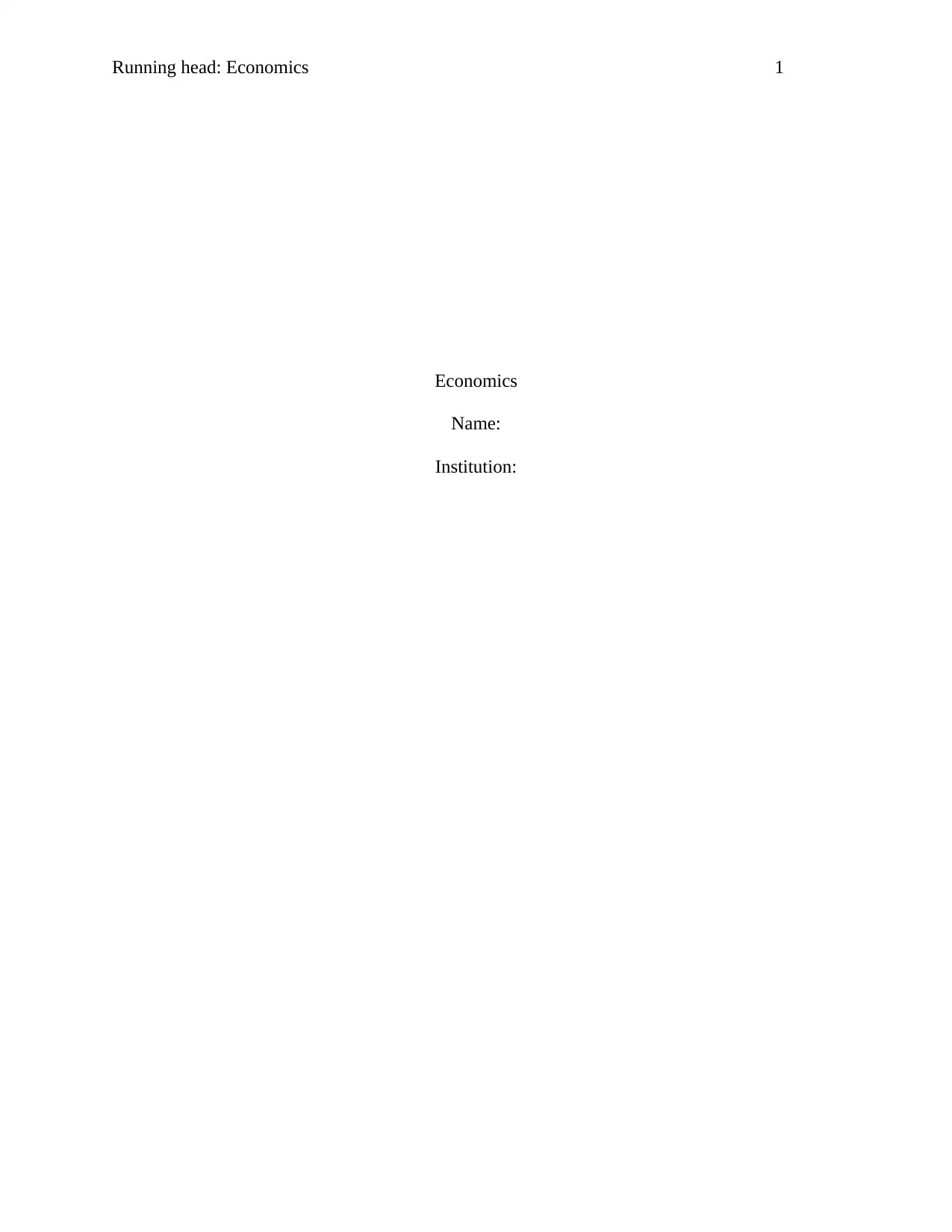
Running head: Economics 1
Economics
Name:
Institution:
Economics
Name:
Institution:
Paraphrase This Document
Need a fresh take? Get an instant paraphrase of this document with our AI Paraphraser
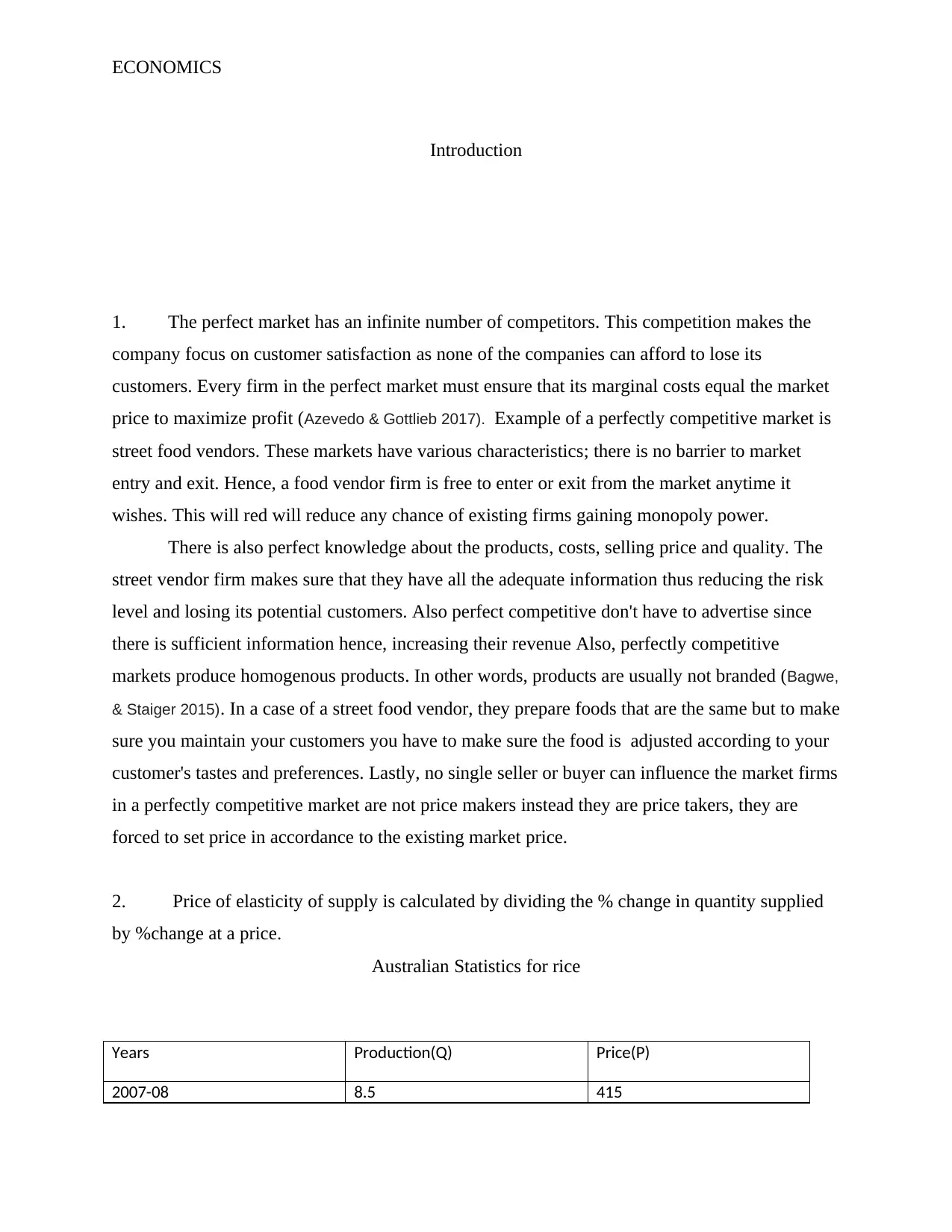
ECONOMICS
Introduction
1. The perfect market has an infinite number of competitors. This competition makes the
company focus on customer satisfaction as none of the companies can afford to lose its
customers. Every firm in the perfect market must ensure that its marginal costs equal the market
price to maximize profit (Azevedo & Gottlieb 2017). Example of a perfectly competitive market is
street food vendors. These markets have various characteristics; there is no barrier to market
entry and exit. Hence, a food vendor firm is free to enter or exit from the market anytime it
wishes. This will red will reduce any chance of existing firms gaining monopoly power.
There is also perfect knowledge about the products, costs, selling price and quality. The
street vendor firm makes sure that they have all the adequate information thus reducing the risk
level and losing its potential customers. Also perfect competitive don't have to advertise since
there is sufficient information hence, increasing their revenue Also, perfectly competitive
markets produce homogenous products. In other words, products are usually not branded (Bagwe,
& Staiger 2015). In a case of a street food vendor, they prepare foods that are the same but to make
sure you maintain your customers you have to make sure the food is adjusted according to your
customer's tastes and preferences. Lastly, no single seller or buyer can influence the market firms
in a perfectly competitive market are not price makers instead they are price takers, they are
forced to set price in accordance to the existing market price.
2. Price of elasticity of supply is calculated by dividing the % change in quantity supplied
by %change at a price.
Australian Statistics for rice
Years Production(Q) Price(P)
2007-08 8.5 415
Introduction
1. The perfect market has an infinite number of competitors. This competition makes the
company focus on customer satisfaction as none of the companies can afford to lose its
customers. Every firm in the perfect market must ensure that its marginal costs equal the market
price to maximize profit (Azevedo & Gottlieb 2017). Example of a perfectly competitive market is
street food vendors. These markets have various characteristics; there is no barrier to market
entry and exit. Hence, a food vendor firm is free to enter or exit from the market anytime it
wishes. This will red will reduce any chance of existing firms gaining monopoly power.
There is also perfect knowledge about the products, costs, selling price and quality. The
street vendor firm makes sure that they have all the adequate information thus reducing the risk
level and losing its potential customers. Also perfect competitive don't have to advertise since
there is sufficient information hence, increasing their revenue Also, perfectly competitive
markets produce homogenous products. In other words, products are usually not branded (Bagwe,
& Staiger 2015). In a case of a street food vendor, they prepare foods that are the same but to make
sure you maintain your customers you have to make sure the food is adjusted according to your
customer's tastes and preferences. Lastly, no single seller or buyer can influence the market firms
in a perfectly competitive market are not price makers instead they are price takers, they are
forced to set price in accordance to the existing market price.
2. Price of elasticity of supply is calculated by dividing the % change in quantity supplied
by %change at a price.
Australian Statistics for rice
Years Production(Q) Price(P)
2007-08 8.5 415
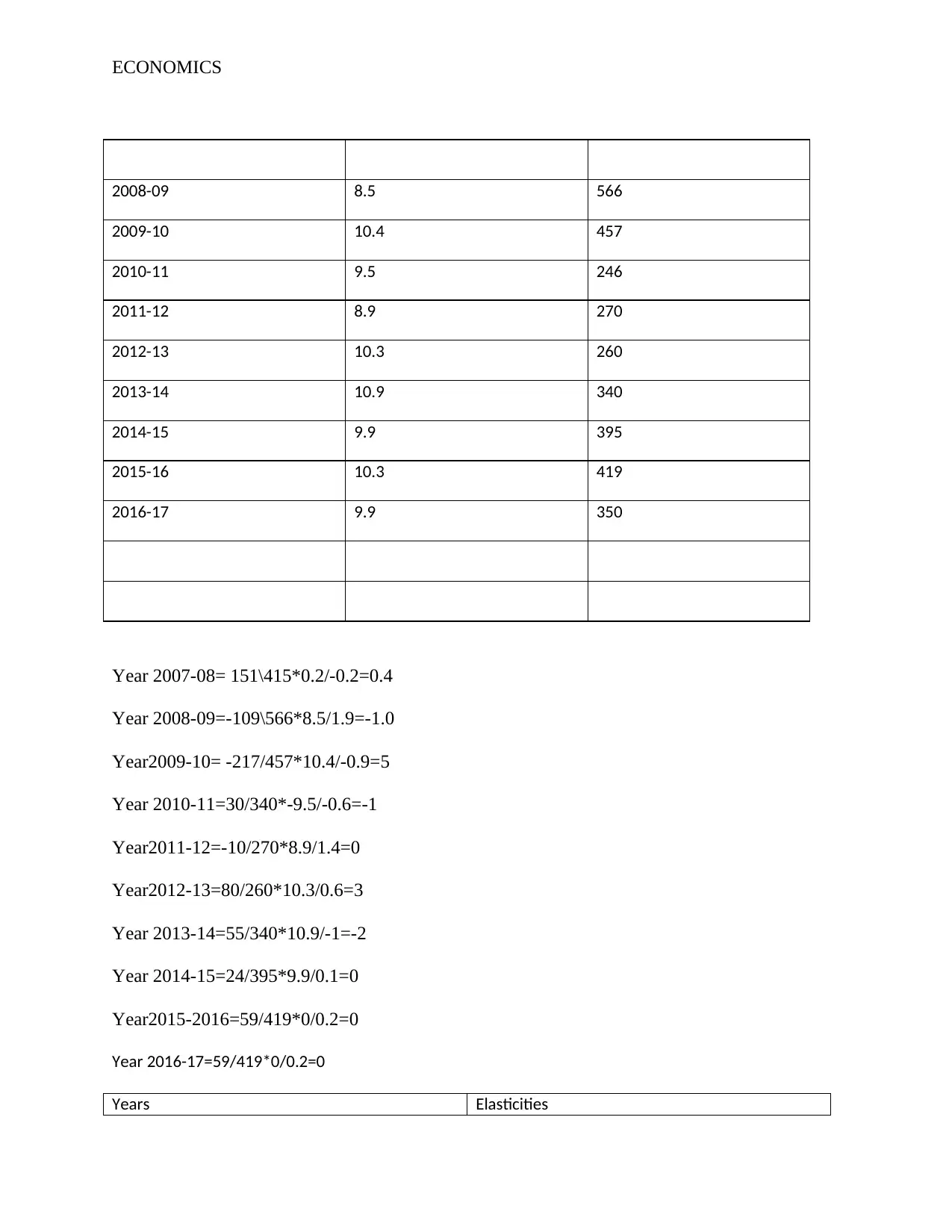
ECONOMICS
2008-09 8.5 566
2009-10 10.4 457
2010-11 9.5 246
2011-12 8.9 270
2012-13 10.3 260
2013-14 10.9 340
2014-15 9.9 395
2015-16 10.3 419
2016-17 9.9 350
Year 2007-08= 151\415*0.2/-0.2=0.4
Year 2008-09=-109\566*8.5/1.9=-1.0
Year2009-10= -217/457*10.4/-0.9=5
Year 2010-11=30/340*-9.5/-0.6=-1
Year2011-12=-10/270*8.9/1.4=0
Year2012-13=80/260*10.3/0.6=3
Year 2013-14=55/340*10.9/-1=-2
Year 2014-15=24/395*9.9/0.1=0
Year2015-2016=59/419*0/0.2=0
Year 2016-17=59/419*0/0.2=0
Years Elasticities
2008-09 8.5 566
2009-10 10.4 457
2010-11 9.5 246
2011-12 8.9 270
2012-13 10.3 260
2013-14 10.9 340
2014-15 9.9 395
2015-16 10.3 419
2016-17 9.9 350
Year 2007-08= 151\415*0.2/-0.2=0.4
Year 2008-09=-109\566*8.5/1.9=-1.0
Year2009-10= -217/457*10.4/-0.9=5
Year 2010-11=30/340*-9.5/-0.6=-1
Year2011-12=-10/270*8.9/1.4=0
Year2012-13=80/260*10.3/0.6=3
Year 2013-14=55/340*10.9/-1=-2
Year 2014-15=24/395*9.9/0.1=0
Year2015-2016=59/419*0/0.2=0
Year 2016-17=59/419*0/0.2=0
Years Elasticities
⊘ This is a preview!⊘
Do you want full access?
Subscribe today to unlock all pages.

Trusted by 1+ million students worldwide
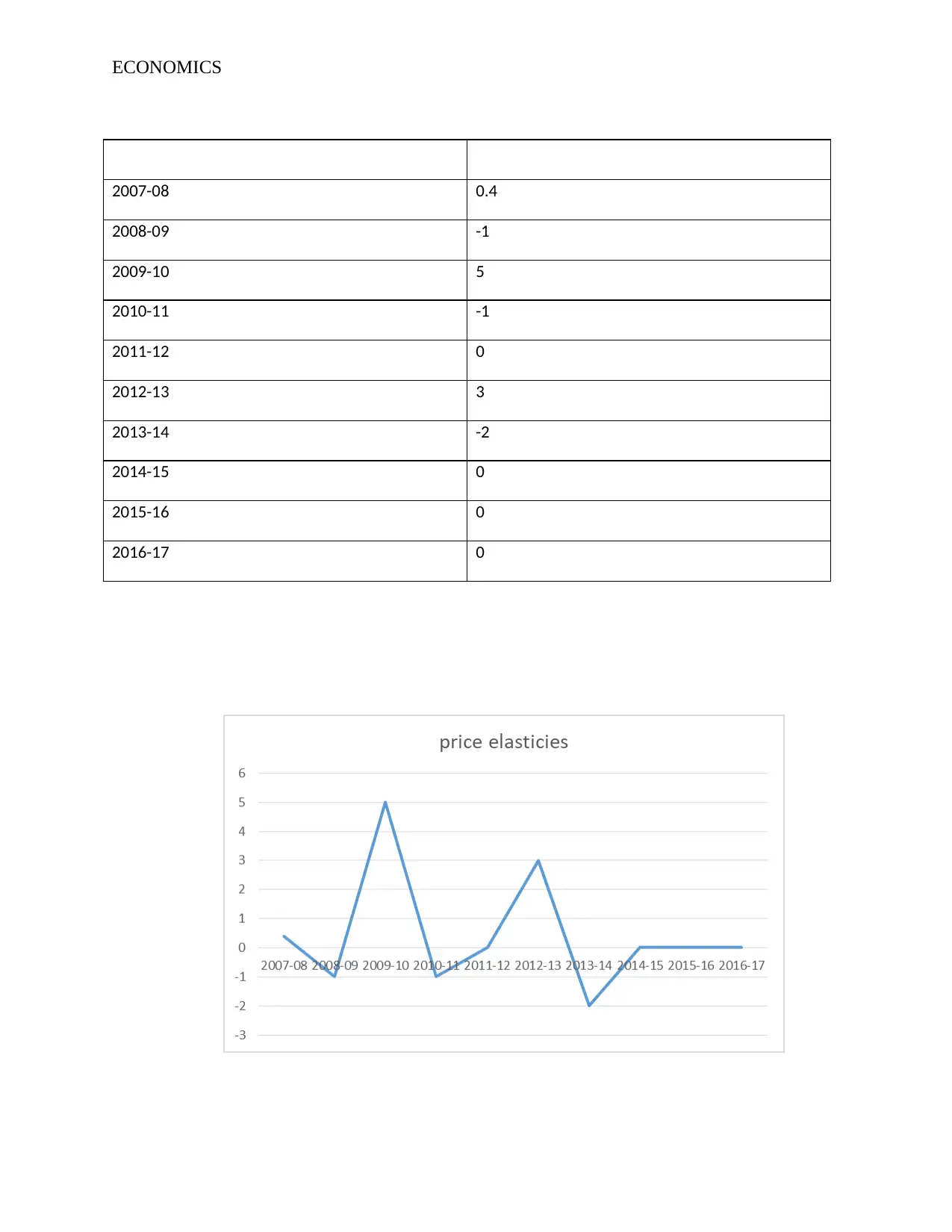
ECONOMICS
2007-08 0.4
2008-09 -1
2009-10 5
2010-11 -1
2011-12 0
2012-13 3
2013-14 -2
2014-15 0
2015-16 0
2016-17 0
2007-08 0.4
2008-09 -1
2009-10 5
2010-11 -1
2011-12 0
2012-13 3
2013-14 -2
2014-15 0
2015-16 0
2016-17 0
Paraphrase This Document
Need a fresh take? Get an instant paraphrase of this document with our AI Paraphraser
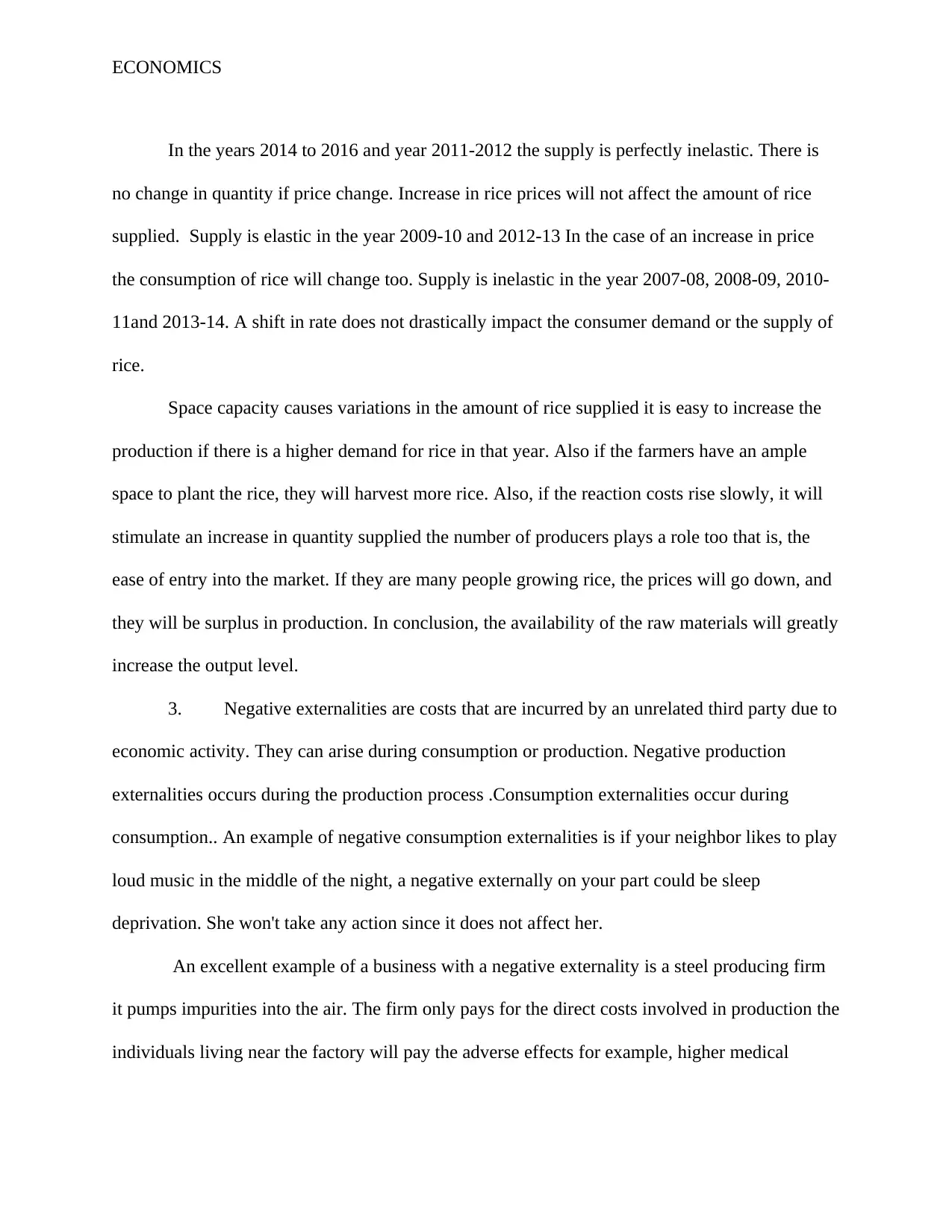
ECONOMICS
In the years 2014 to 2016 and year 2011-2012 the supply is perfectly inelastic. There is
no change in quantity if price change. Increase in rice prices will not affect the amount of rice
supplied. Supply is elastic in the year 2009-10 and 2012-13 In the case of an increase in price
the consumption of rice will change too. Supply is inelastic in the year 2007-08, 2008-09, 2010-
11and 2013-14. A shift in rate does not drastically impact the consumer demand or the supply of
rice.
Space capacity causes variations in the amount of rice supplied it is easy to increase the
production if there is a higher demand for rice in that year. Also if the farmers have an ample
space to plant the rice, they will harvest more rice. Also, if the reaction costs rise slowly, it will
stimulate an increase in quantity supplied the number of producers plays a role too that is, the
ease of entry into the market. If they are many people growing rice, the prices will go down, and
they will be surplus in production. In conclusion, the availability of the raw materials will greatly
increase the output level.
3. Negative externalities are costs that are incurred by an unrelated third party due to
economic activity. They can arise during consumption or production. Negative production
externalities occurs during the production process .Consumption externalities occur during
consumption.. An example of negative consumption externalities is if your neighbor likes to play
loud music in the middle of the night, a negative externally on your part could be sleep
deprivation. She won't take any action since it does not affect her.
An excellent example of a business with a negative externality is a steel producing firm
it pumps impurities into the air. The firm only pays for the direct costs involved in production the
individuals living near the factory will pay the adverse effects for example, higher medical
In the years 2014 to 2016 and year 2011-2012 the supply is perfectly inelastic. There is
no change in quantity if price change. Increase in rice prices will not affect the amount of rice
supplied. Supply is elastic in the year 2009-10 and 2012-13 In the case of an increase in price
the consumption of rice will change too. Supply is inelastic in the year 2007-08, 2008-09, 2010-
11and 2013-14. A shift in rate does not drastically impact the consumer demand or the supply of
rice.
Space capacity causes variations in the amount of rice supplied it is easy to increase the
production if there is a higher demand for rice in that year. Also if the farmers have an ample
space to plant the rice, they will harvest more rice. Also, if the reaction costs rise slowly, it will
stimulate an increase in quantity supplied the number of producers plays a role too that is, the
ease of entry into the market. If they are many people growing rice, the prices will go down, and
they will be surplus in production. In conclusion, the availability of the raw materials will greatly
increase the output level.
3. Negative externalities are costs that are incurred by an unrelated third party due to
economic activity. They can arise during consumption or production. Negative production
externalities occurs during the production process .Consumption externalities occur during
consumption.. An example of negative consumption externalities is if your neighbor likes to play
loud music in the middle of the night, a negative externally on your part could be sleep
deprivation. She won't take any action since it does not affect her.
An excellent example of a business with a negative externality is a steel producing firm
it pumps impurities into the air. The firm only pays for the direct costs involved in production the
individuals living near the factory will pay the adverse effects for example, higher medical
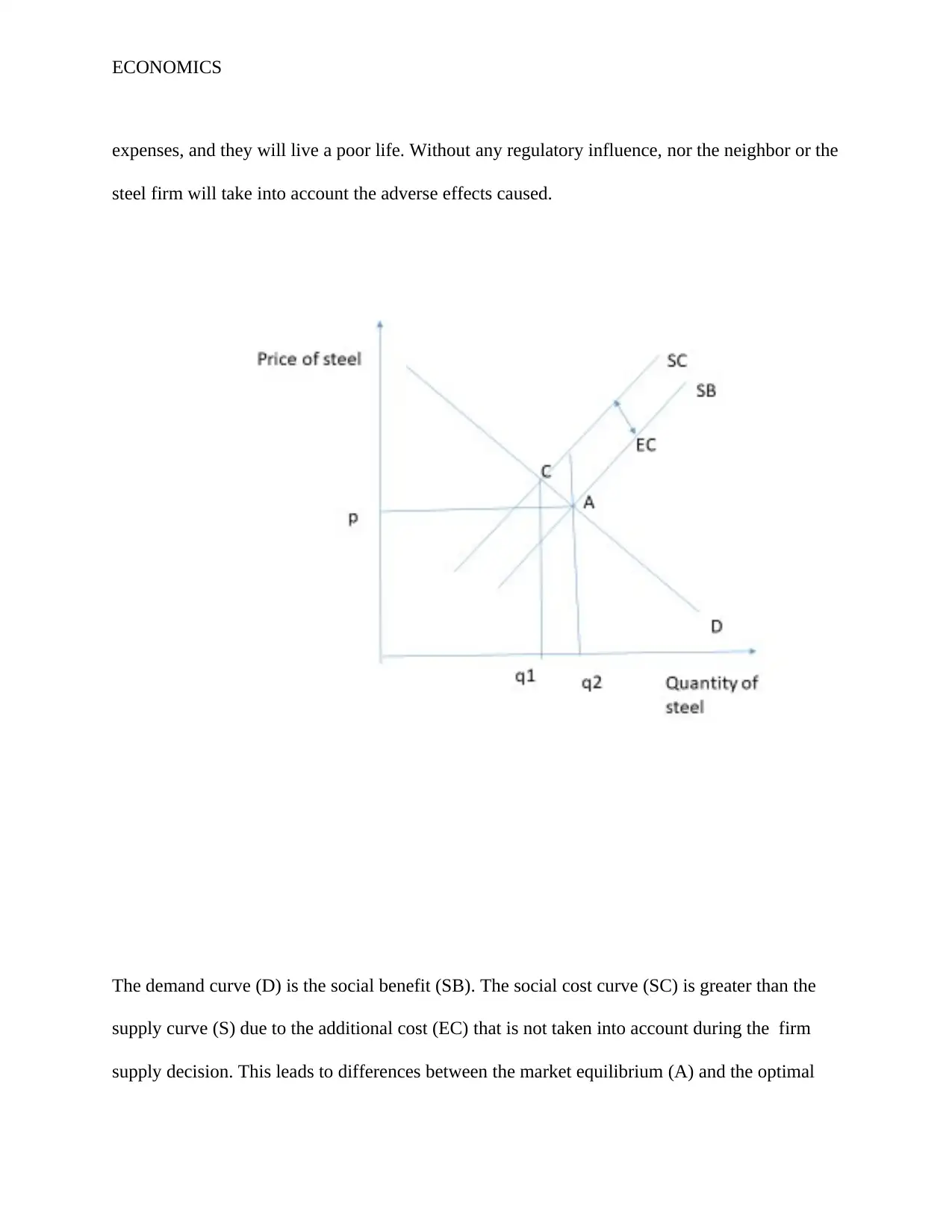
ECONOMICS
expenses, and they will live a poor life. Without any regulatory influence, nor the neighbor or the
steel firm will take into account the adverse effects caused.
The demand curve (D) is the social benefit (SB). The social cost curve (SC) is greater than the
supply curve (S) due to the additional cost (EC) that is not taken into account during the firm
supply decision. This leads to differences between the market equilibrium (A) and the optimal
expenses, and they will live a poor life. Without any regulatory influence, nor the neighbor or the
steel firm will take into account the adverse effects caused.
The demand curve (D) is the social benefit (SB). The social cost curve (SC) is greater than the
supply curve (S) due to the additional cost (EC) that is not taken into account during the firm
supply decision. This leads to differences between the market equilibrium (A) and the optimal
⊘ This is a preview!⊘
Do you want full access?
Subscribe today to unlock all pages.

Trusted by 1+ million students worldwide
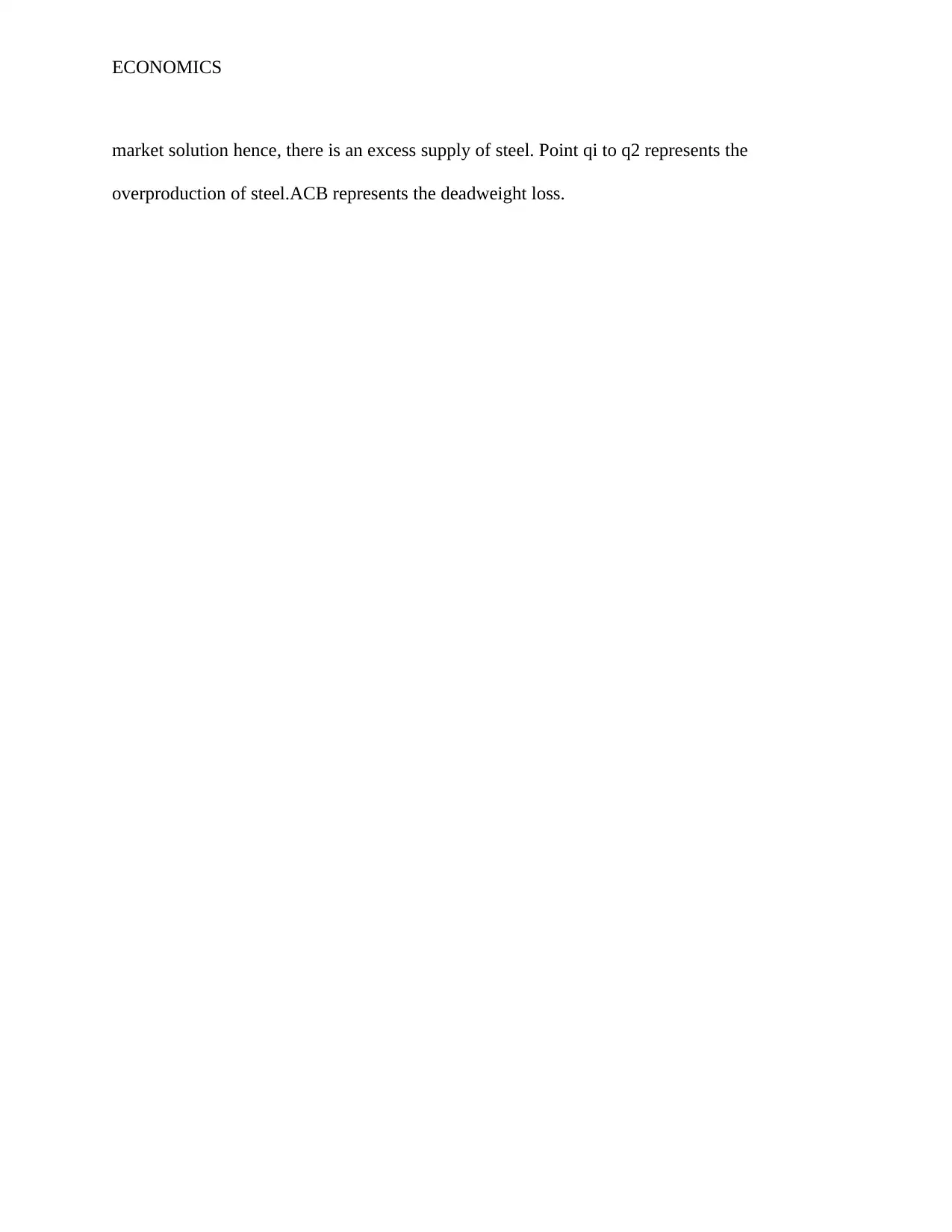
ECONOMICS
market solution hence, there is an excess supply of steel. Point qi to q2 represents the
overproduction of steel.ACB represents the deadweight loss.
market solution hence, there is an excess supply of steel. Point qi to q2 represents the
overproduction of steel.ACB represents the deadweight loss.
Paraphrase This Document
Need a fresh take? Get an instant paraphrase of this document with our AI Paraphraser
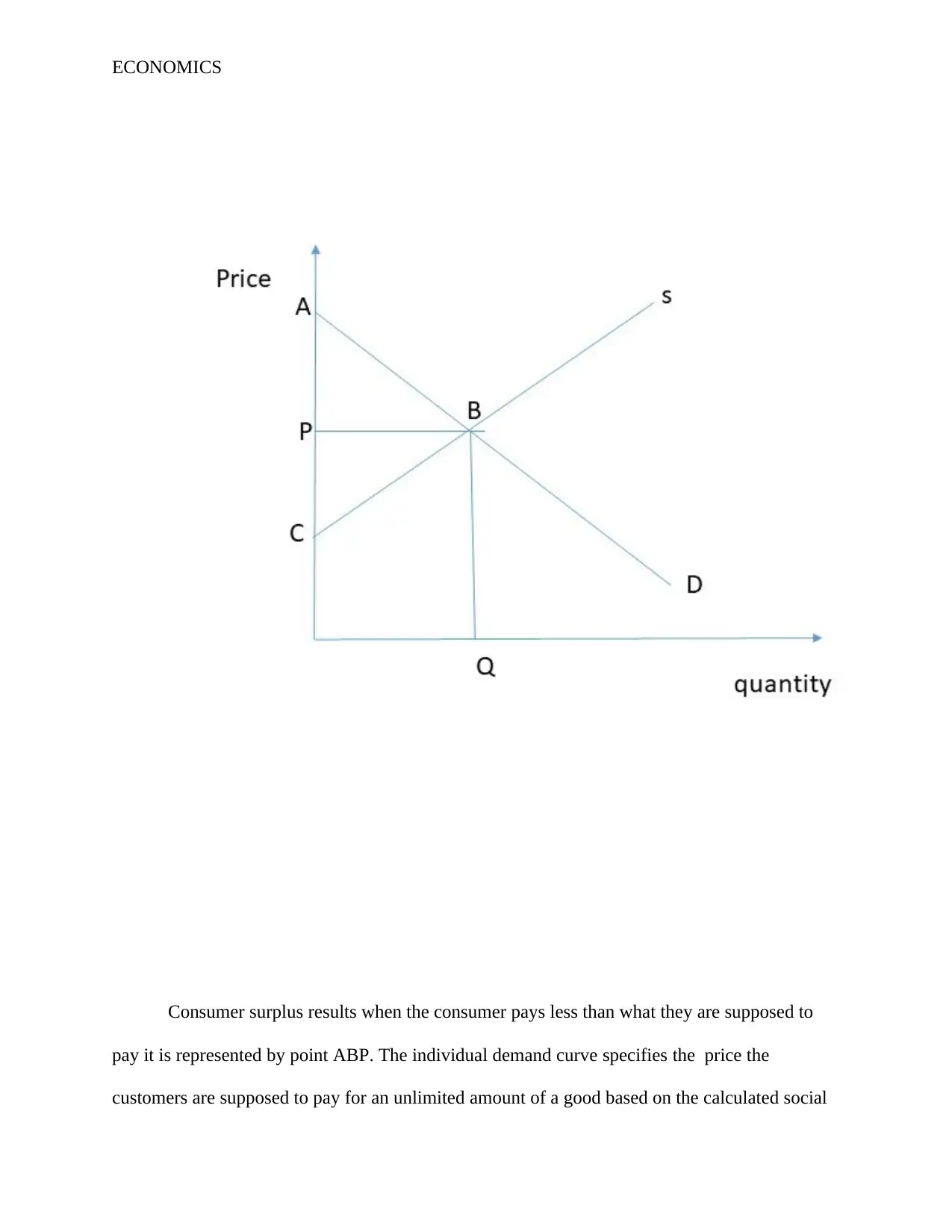
ECONOMICS
Consumer surplus results when the consumer pays less than what they are supposed to
pay it is represented by point ABP. The individual demand curve specifies the price the
customers are supposed to pay for an unlimited amount of a good based on the calculated social
Consumer surplus results when the consumer pays less than what they are supposed to
pay it is represented by point ABP. The individual demand curve specifies the price the
customers are supposed to pay for an unlimited amount of a good based on the calculated social
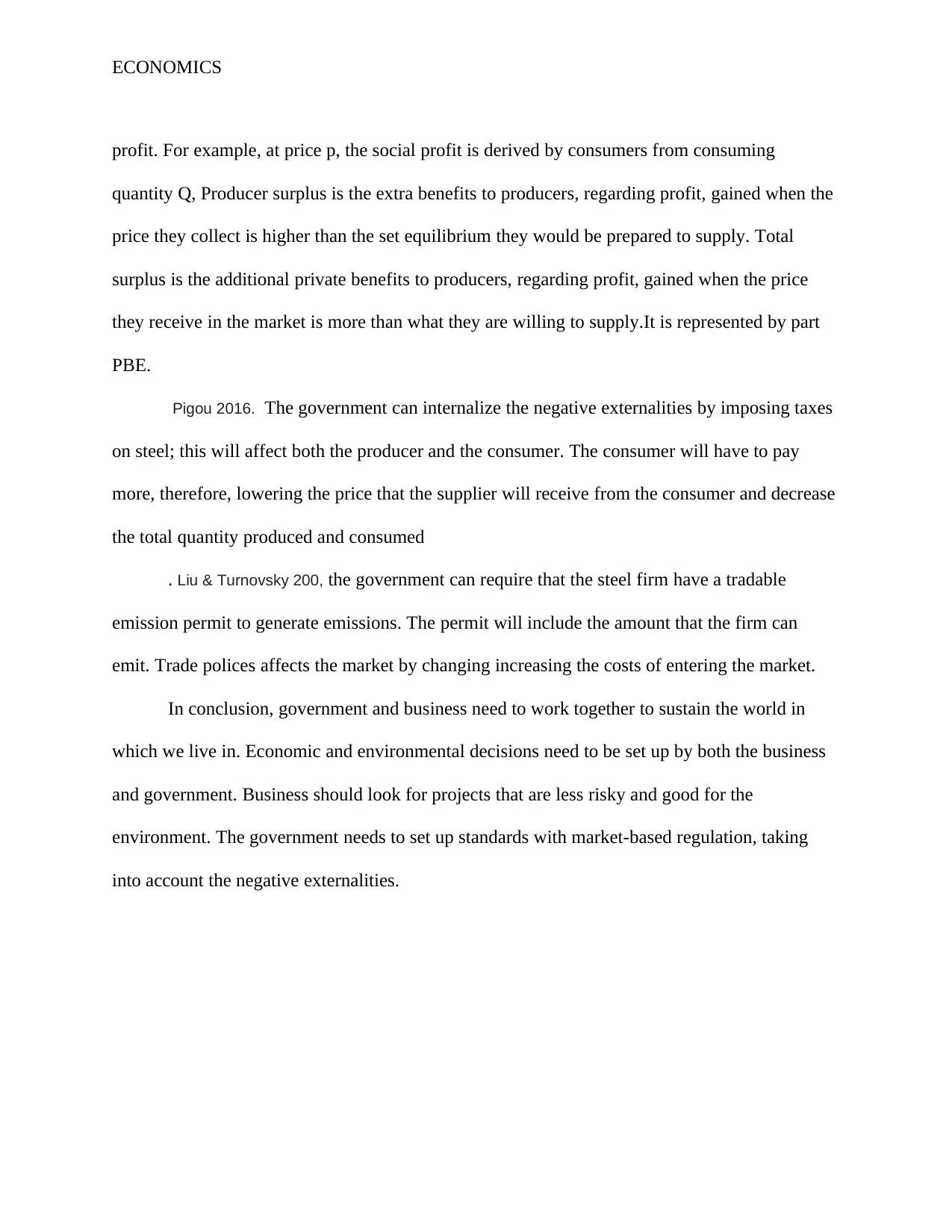
ECONOMICS
profit. For example, at price p, the social profit is derived by consumers from consuming
quantity Q, Producer surplus is the extra benefits to producers, regarding profit, gained when the
price they collect is higher than the set equilibrium they would be prepared to supply. Total
surplus is the additional private benefits to producers, regarding profit, gained when the price
they receive in the market is more than what they are willing to supply.It is represented by part
PBE.
Pigou 2016. The government can internalize the negative externalities by imposing taxes
on steel; this will affect both the producer and the consumer. The consumer will have to pay
more, therefore, lowering the price that the supplier will receive from the consumer and decrease
the total quantity produced and consumed
. Liu & Turnovsky 200, the government can require that the steel firm have a tradable
emission permit to generate emissions. The permit will include the amount that the firm can
emit. Trade polices affects the market by changing increasing the costs of entering the market.
In conclusion, government and business need to work together to sustain the world in
which we live in. Economic and environmental decisions need to be set up by both the business
and government. Business should look for projects that are less risky and good for the
environment. The government needs to set up standards with market-based regulation, taking
into account the negative externalities.
profit. For example, at price p, the social profit is derived by consumers from consuming
quantity Q, Producer surplus is the extra benefits to producers, regarding profit, gained when the
price they collect is higher than the set equilibrium they would be prepared to supply. Total
surplus is the additional private benefits to producers, regarding profit, gained when the price
they receive in the market is more than what they are willing to supply.It is represented by part
PBE.
Pigou 2016. The government can internalize the negative externalities by imposing taxes
on steel; this will affect both the producer and the consumer. The consumer will have to pay
more, therefore, lowering the price that the supplier will receive from the consumer and decrease
the total quantity produced and consumed
. Liu & Turnovsky 200, the government can require that the steel firm have a tradable
emission permit to generate emissions. The permit will include the amount that the firm can
emit. Trade polices affects the market by changing increasing the costs of entering the market.
In conclusion, government and business need to work together to sustain the world in
which we live in. Economic and environmental decisions need to be set up by both the business
and government. Business should look for projects that are less risky and good for the
environment. The government needs to set up standards with market-based regulation, taking
into account the negative externalities.
⊘ This is a preview!⊘
Do you want full access?
Subscribe today to unlock all pages.

Trusted by 1+ million students worldwide
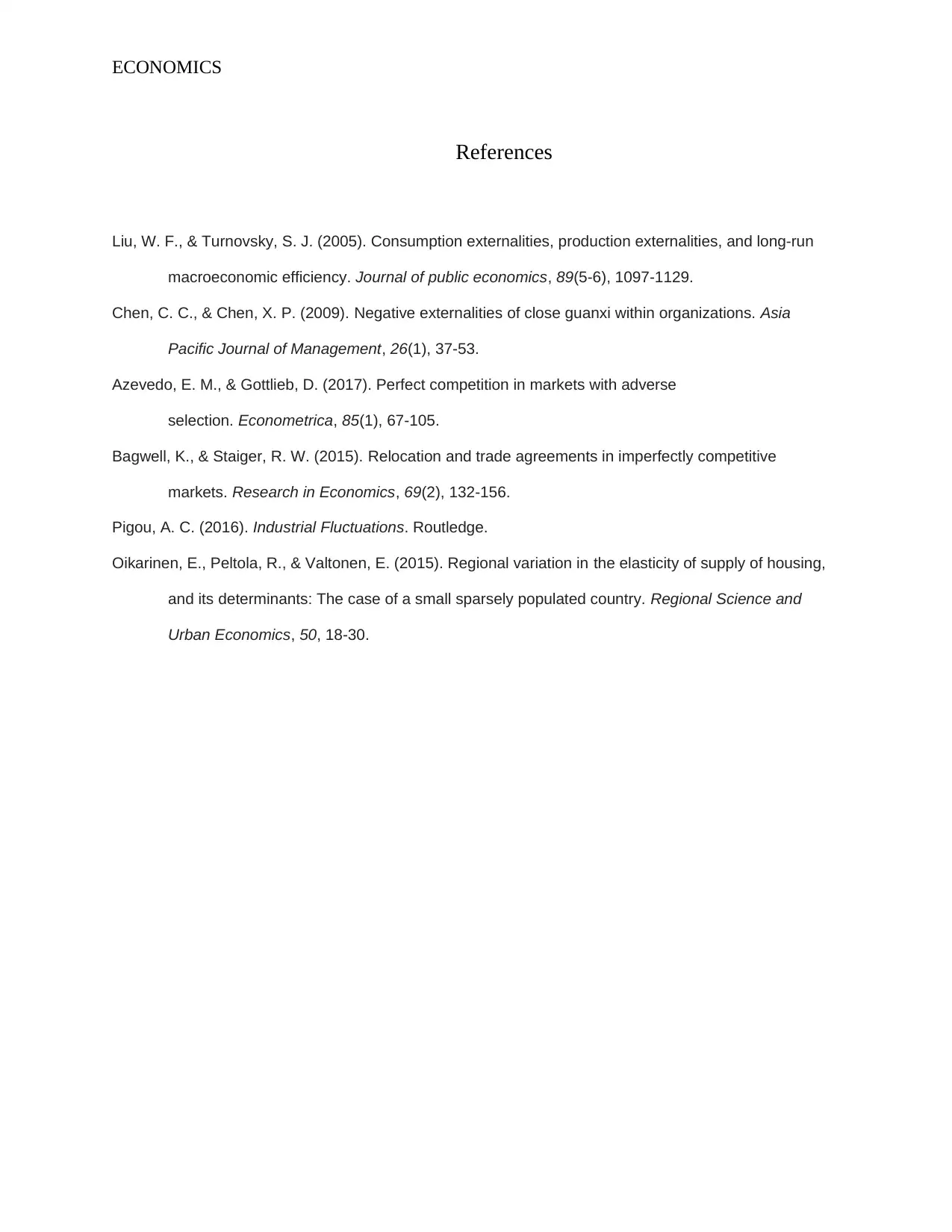
ECONOMICS
References
Liu, W. F., & Turnovsky, S. J. (2005). Consumption externalities, production externalities, and long-run
macroeconomic efficiency. Journal of public economics, 89(5-6), 1097-1129.
Chen, C. C., & Chen, X. P. (2009). Negative externalities of close guanxi within organizations. Asia
Pacific Journal of Management, 26(1), 37-53.
Azevedo, E. M., & Gottlieb, D. (2017). Perfect competition in markets with adverse
selection. Econometrica, 85(1), 67-105.
Bagwell, K., & Staiger, R. W. (2015). Relocation and trade agreements in imperfectly competitive
markets. Research in Economics, 69(2), 132-156.
Pigou, A. C. (2016). Industrial Fluctuations. Routledge.
Oikarinen, E., Peltola, R., & Valtonen, E. (2015). Regional variation in the elasticity of supply of housing,
and its determinants: The case of a small sparsely populated country. Regional Science and
Urban Economics, 50, 18-30.
References
Liu, W. F., & Turnovsky, S. J. (2005). Consumption externalities, production externalities, and long-run
macroeconomic efficiency. Journal of public economics, 89(5-6), 1097-1129.
Chen, C. C., & Chen, X. P. (2009). Negative externalities of close guanxi within organizations. Asia
Pacific Journal of Management, 26(1), 37-53.
Azevedo, E. M., & Gottlieb, D. (2017). Perfect competition in markets with adverse
selection. Econometrica, 85(1), 67-105.
Bagwell, K., & Staiger, R. W. (2015). Relocation and trade agreements in imperfectly competitive
markets. Research in Economics, 69(2), 132-156.
Pigou, A. C. (2016). Industrial Fluctuations. Routledge.
Oikarinen, E., Peltola, R., & Valtonen, E. (2015). Regional variation in the elasticity of supply of housing,
and its determinants: The case of a small sparsely populated country. Regional Science and
Urban Economics, 50, 18-30.
1 out of 10
Your All-in-One AI-Powered Toolkit for Academic Success.
+13062052269
info@desklib.com
Available 24*7 on WhatsApp / Email
![[object Object]](/_next/static/media/star-bottom.7253800d.svg)
Unlock your academic potential
Copyright © 2020–2025 A2Z Services. All Rights Reserved. Developed and managed by ZUCOL.